Heatherton Tuberculosis Sanatorium
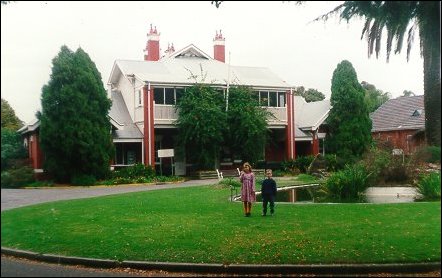
Heatherton Sanatorium.
Not long after the opening of the Melbourne Benevolent Asylum at Heatherton in 1909, the then board of the ‘Department of Public Health’ requested that the government look into building a number of hospitals for the treatment of ‘Consumption’.
The main criteria for the treatment of this ailment was rest, fresh air and sunshine and good food, so what better place to build a ‘Sanatorium’ than in the rural area they called Heatherton and affiliate it with the Melbourne Benevolent Asylum.
After consultation, the government of the day decided that the ‘Heatherton Sanatorium’ would be built. It was officially opened on May 27, 1913 and for a time was administered from the Melbourne Benevolent Asylum. The Asylum supplied the staff, food and other requirements needed to enable the hospital to function.
In 1914, not long after the opening of the Heatherton Hospital the government issued the following statement:
"The care of consumptives is now under the control of the Public Health Department and to help combat this problem this Government has recently erected at its own cost, at Cheltenham, a modern hospital building to be known as ‘The Heatherton Sanatorium’ and it will be used for the reception of advanced cases of consumption, this hospital provides 100 beds and the cost of maintaining this institution is to be divided equally between the Government and the Metropolitan Municipalities."
After the patients and staff had settled in and all things were going well it was realised there was a need for more patient recreation and entertainment within the confines of the hospital grounds. So a decision was made to build a concert hall. In 1919 the hospital officially opened its own concert hall, providing the patients with another form of rehabilitation therapy. They could now produce their own plays, hold concerts and attend the showing of moving pictures.
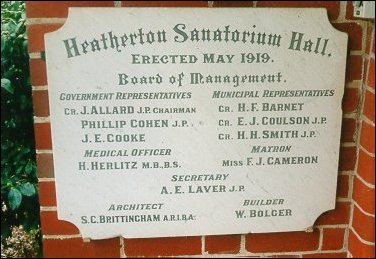
Plaque on wall of concert hall.
During the 1920’s the Heatherton Hospital and the Melbourne Benevolent Asylum were linked by an electric tram like conveyance that was used to transport food and other essential items required by the Heatherton Hospital. This tram line ceased to exist in the mid 1940’s just after World War II when the Commonwealth Government Health Department took over the Heatherton Hospital to deal with tuberculosis when it became a major problem in Australia. This was during the time when the government conducted X-Ray surveys on a state by state basis. It was compulsory at that time for everyone to have a chest X-Ray.
The increase in the number of people identified as suffering from tuberculosis created a need for additional beds and to alleviate overcrowding at Heatherton two new modern hospital blocks were build on the site. One was known as "North Block", where female patients were accommodated and the other was called "South Block" where male patients were housed. For this work to be carried out the fowl pens that were situated at the east end of the hospital were demolished and the tennis courts were moved from the west end of the hospital near the doctor’s residence. At the same time the children who were admitted suffering from tuberculosis were hospitalised in Wing 2.
There were many other buildings constructed about this time. Several two storey residences were built along Kingston Road, next to the medical superintendent’s house. At the rear of the hospital another five houses were built for the staff. An additional five staff houses were constructed on the corners of Kingston Road and Byng Avenue. These residences were built because of the need to have professional and skilled staff living on the site. Something extra had to be offered to keep such people as the Senior Resident Medical Officer, and other permanent Residential Medical staff working at the hospital. In those days unless there was some type of inducement it was not easy to entice professional and experienced staff to a place such as Heatherton which was still virtually classified as a rural country area.
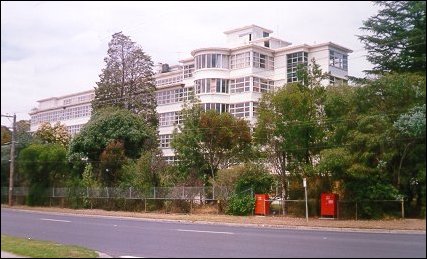
Nurses home, 1998.
In 1952/53 to complete the overall development of the hospital site a modern five story hostel for nursing staff and trainee nurses was constructed. With the completion of this nurses’ home the hospital became fully self sufficient in all aspects. It now housed approximately 260 patients, it had its own nursing staff, administration and domestic staff, an engineering and gardening department, laundry and kitchen; all ties with the Melbourne Benevolent Asylum having been severed.
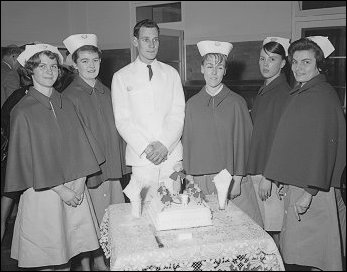
Graduating as nursing aides, 1964. From the Leader Collection.
Over eighty-four years the Heatherton Hospital, like the Kingston Centre, had a substantial impact on the lives of many of the residents that lived in the Heatherton area. Many worked at the hospital in one way or another, some in the capacity of professional nursing staff, or with the administration section, some worked as domestic and cleaning staff and others worked in the kitchen or laundry. The majority of gardeners and plumbers, carpenters and electricians employed in the engineering section lived in Heatherton or in surrounding districts.
There was a very strong social club for employees of the hospital. Something was always happening in which the families of staff could join. There were wonderful Christmas parties for the children. Staff and family members had full use of the tennis courts, could play billiards or snooker and could join in concerts and film nights provided for the patients. It was a close knit community where people knew each other and worked and socialised together in harmony.
Tuberculosis reached its peak in the late 1950’s and the patient intake was on the decline by 1958. As a result Prince Henry’s Hospital was offered the use of part of the Heatherton facilities as a convalescent hospital. In 1968 the Thoracic Ward at the Austin Hospital was closed and the last of their T.B. patients were transferred to the Heatherton Hospital. As most of these patients were between 5 and 17 years the government established another school in Heatherton to cater for their education. This school was part of the hospital and was known as Heatherton Hospital State School, No 4982. The Head Teacher was Mrs Elizabeth Ennis and her assistant was Mrs Cora Phillips.
By 1970 the tuberculosis problem had virtually come to an end and only a few T.B. patients were still being treated at the Heatherton site. In 1974 the Minister of Health decided that the "Alcohol and Drug Dependant Persons Services Branch" would become the new tenants of the Heatherton facility. They took over Wings 1 and 2, and the Prince Henry’s Hospital took up an offer to utilise additional space.December 1976 saw the responsibility for running and financing the Heatherton Sanatorium revert from Federal to State Government. The name Heatherton Sanatorium was changed to Heatherton Hospital. About this time someone circulated a report to the staff stating, "We are now entering an age of uncertainty into the future of the Heatherton Hospital." Many of the areas that required urgent attention were shelved because what management was then calling the "Uncertainty Principle"
In 1980/91 the State government again reviewed the State’s hospital system and decided that places such as the Willsmere hospital at Kew should be closed and the properties sold. Once that decision was ratified it was decided that Heatherton Hospital would accommodate the Willsmere patients so the North and South blocks were refurbished.The first of the psychiatric patients from the old Willsmere hospital were admitted to Heatherton on April 21, 1987. At that time the then Minister of Health declared that Heatherton Hospital was now a Psychiatric Hospital for the elderly. Gradually the buildings started to look tired and run down through lack of maintenance. The surrounding grounds and gardens which had always been immaculate began to look neglected.
In 1993, when the Liberal Government came to office the hospital system was reviewed and as a consequence the Heatherton Hospital was again brought under the umbrella of Kingston Centre, originally the Melbourne Benevolent Asylum, and patients at Heatherton were moved to other locations, such as Kingston, Dandenong and Alfred hospitals. Heatherton Hospital was officially closed on January 30, 1998.
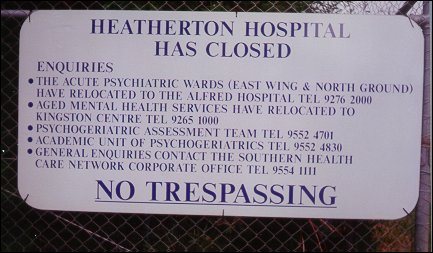
Heatherton Sanatorium closed.
